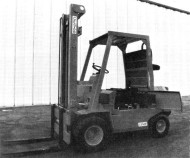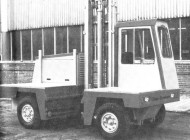 Welcome to episode sixty three in our exclusive series on the history of the fork lift truck, the machine which over the decades has revolutionised the face of materials handling around the world. We’ve now reached 1977, the year of the first ever Mechanical Handling Exhibition, IMHX’s forerunner, at the then brand new NEC, the Queen’s Silver Jubilee and for music fans the heyday of punk rock.
Welcome to episode sixty three in our exclusive series on the history of the fork lift truck, the machine which over the decades has revolutionised the face of materials handling around the world. We’ve now reached 1977, the year of the first ever Mechanical Handling Exhibition, IMHX’s forerunner, at the then brand new NEC, the Queen’s Silver Jubilee and for music fans the heyday of punk rock.
Our writer is James Brindley, an acknowledged authority on fork lift trucks. James’s distinguished career has involved engineering and management roles with BT Rolatruc and serving as a Director of the FLTA, before he set up the National Fork Truck Heritage Centre in 2004 as Britain’s first such collection open to the public.
For the time being this is the last episode in the series, as James Brindley explains: “On a personal note my own circumstances make it necessary to suspend my writing of the history articles in Warehouse & Logistics News as from this date. Hopefully this action will make it easier to complete my book on fork lift history, which will contain information and references to the large and small companies alike. Many of the smaller businesses have already been taken over, and if information is not recorded soon then it will disappear forever. When my book has been completed, I would like and hope to continue with my history articles for W&LN once again.
 In conclusion I wish to take this opportunity to extend my many thanks to all those who have helped and supported me in my endeavours over the last six years of writing.”
In conclusion I wish to take this opportunity to extend my many thanks to all those who have helped and supported me in my endeavours over the last six years of writing.”
Episode 63: 1977: IMHX’s forerunner debuts at NEC
In 1977, the same year that the British people celebrated the Queen’s Jubilee, the newly built National Exhibition Centre, Birmingham hosted its first Mechanical Handling Exhibition. Formerly held at Earls Court, the new venue for MOVEMENT 77- the 16th of the International Mechanical Handling Exhibitions – was a great success due to the excellent facilities and an increase in the number of different categories and types in the equipment shown.
Among the fork lift trucks on display were new models of machines made by Cesab, Jungheinrich, Coventry Climax and Bonser, to name a few. The Italian-made Cesab diesels with hydrostatic transmission by Sauer & Sohn were produced in lifting capacities from 1500-3500kg. A direct injection air-cooled engine made by Alpha Romeo was claimed to offer easy starting in low temperatures. The control for direction was through two pedals that were alongside those for brake and accelerator.
The new Jungheinrich third generation ETX 200 narrow aisle stacker was fitted with a much wider mast. The uprights had a double “T” profile compared to the earlier “L” type and the lift rams were fitted at each side to allow better operator visibility. Coventry Climax, after their acquisition of Shawloader in 1976, displayed a prototype sideloader for appraisal by prospective customers. Its lifting capacity was 5 tonne with stabilisers in position and 4 tonne when lifting free on its road wheels. An added major feature was a tilting deck that had an operative four-point suspension regardless of the tilt angle. The Climax-Shawloader, as it was named, also sported a newly designed cab which now had a flat windscreen instead of the previously fitted convex type. The new machine, with accepted customer modifications, was planned to go into production later in the year.
 A brand new Bonser whose design had moved away from the normal tractor skid based trucks appeared for the very first time at the show. Called the D5000K, the machine featured an integral 3-inch each way side-shifting mast that the manufacturers claimed had no deration and a lifting capacity of 5000 kg at 600 mm. Power was supplied by a Perkins 4.236 diesel engine with a compatible torque converter.
A brand new Bonser whose design had moved away from the normal tractor skid based trucks appeared for the very first time at the show. Called the D5000K, the machine featured an integral 3-inch each way side-shifting mast that the manufacturers claimed had no deration and a lifting capacity of 5000 kg at 600 mm. Power was supplied by a Perkins 4.236 diesel engine with a compatible torque converter.
Out in the field Caterpillar’s new plant at Leicester moved into full production, and in so doing gave a long awaited boost to the Company’s capacity in the UK. The purpose-built plant would eventually take lift truck assembly away from their Gosselies location in Belgium. This would enable the Gosselies factory to concentrate on making hydraulic excavators and tractors.
One year after the Liner “Giraffe” success story, there was news of another player in the telescopic handling market. J C B excavators released news that newly designed machines with a lifting capacity of 2250 kg were under test at locations in the UK and France. Not unlike the “Giraffe,” the JCB 500 series were classed as a rough terrain machine and their first model, the 520 was aimed initially at the construction and agricultural markets. Company expectations were that these machines with the ability to raise fully rated loads to 6.34 metres would also find applications within the industrial sector.
 On behalf of our readers, Warehouse & Logistics News would like to thank James Brindley for his superb work over the past few years bringing us the history of the fork lift truck, and we look forward to bringing you details of his book in due course. Meanwhile the Heritage Centre continues to need your support, and if you or your company would like to help in any way, you can contact James on the number below.
On behalf of our readers, Warehouse & Logistics News would like to thank James Brindley for his superb work over the past few years bringing us the history of the fork lift truck, and we look forward to bringing you details of his book in due course. Meanwhile the Heritage Centre continues to need your support, and if you or your company would like to help in any way, you can contact James on the number below.
By James Brindley, Director, National Fork Truck Heritage Centre.
If you would like to support the National Fork Truck Heritage Centre, please call James Brindley on 0780 195 4167




Comments are closed.